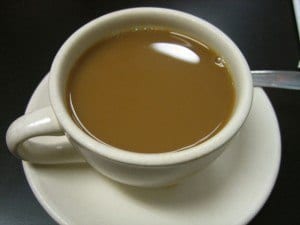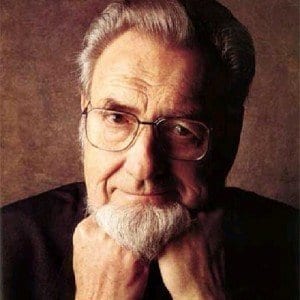
Coffee falls into the stomach … ideas begin to move, things remembered arrive at full gallop … the shafts of wit start up like sharp-shooters, similies arise, the paper is covered with ink … – Honoré de Balzac
That first cup of morning coffee. Is there a better way to start your day? Or to relax with friends after a good meal?
Coffee comes from a tropical evergreen shrub. The bean like seeds are roasted and ground to produce the drink of the same name. Most coffee drinkers know what they like, but know little about how the steaming hot brew got from the far off mountains of exotic countries to their coffee maker.
Legend says that the story of coffee began in the year 850 in the Ethiopia highlands. A goat herder named Kaldi was watching his goats and noticed that they became more active, dashing around the fields, and not wanting to sleep at night. Thinking that this may have been a reaction to something they had eaten, Kaldi followed them.
Kaldi found that the goats had been eating red berries from a shrub. So he tried them himself and soon was frolicking with the goats.
Legends have a way of evolving so either Kaldi told a local monk about the beans, or a monk walked by and saw Kaldi frolicking among the goats. However the monk found the beans, he shared them with his brothers and after consuming them they found divine inspiration. Not only that, the coffee helped them stay awake through long hours of prayer.
The story of Kaldi may be just a legend. But it bears elements of truth. Coffee did in fact come from Ethiopia and still grows wild there.
But it wasn’t until the year 1100 when coffee made it to the Arabian Peninsula that the real story of coffee began.
The Arabs were the first people to cultivate coffee. Their climate was conducive to the growing of the plant. Coffee was being grown in the Yemeni district of Arabia by the fifteenth century and was known in Persia, Egypt, Syria and Turkey by the sixteenth century.
Did coffee become popular among the Arabs because Muslims are forbidden to drink alcohol? Various sources comment that many Arabs enjoyed the “exhilarating” effects of coffee. It seemed to fit the Muslim lifestyle of praying five times a day and keeping them awake through those times.
Whether the story of Kaldi and the monastery is true, it is apparent religion played a role in the popularity of coffee.
Coffee houses or qahveh khaneh became popular in Arabia and coffee soon became the Arab’s social drink of choice. But the coffee houses weren’t just about the strong, black drink they also enjoyed music, conversation, and chess and kept current on the news of the day.
Thousands of pilgrims visited the holy city of Mecca each year from around the world. Word of the “wine of Araby” as coffee was sometimes called began to spread beyond Arabia. As Islam and the Arab Empire spread, so did the love of coffee. Arab merchants traded coffee as often as they could. But the Arabians closely guarded their coffee production.
Europeans started hearing about this amazing dark drink from the East. By the 17th century coffee had made its way to Europe and by mid-century had gained in popularity. But coffee was not without its detractors in Europe who referred to the beverage as the “bitter invention of Satan.” The local clergy of Venice condemned coffee in 1615. Pope Clement VIII was asked to intervene. But to make an informed decision he tried coffee and reportedly found it so enticing that he gave Papal approval saying “This devil’s drink is so delicious…we should cheat the devil by baptizing it.”
Even with the controversy in major cities across Europe coffee houses were springing up and becoming major centers for communication and socializing. “Penny universities” spring up in England where a cup of coffee and stimulating conversation could be had for the price of a penny. By the middle of the 17th century there were over 300 coffee houses in London alone. Edward Lloyd’s Coffee House is what is known today as Lloyd’s of London.
In the New World, tea was the preferred drink. After all the majority of settlers were British. But in 1733 the Boston Tea Party changed that and Americans developed a fondness for coffee. In fact the Boston Tea Party was planned in the Green Dragon, a coffee house. The Continental Congress named coffee the national drink. James Mason invented the coffee percolator in 1865.
Coffee houses were gathering places for revolutionaries like John Adams, George Washington and Paul Revered. The first reading of the Declaration of Independence was outside the Merchant’s Coffee House in Philadelphia. Washington was later inaugurated as President at a New York City coffee house. What was once the Tontine Coffee House evolved into what is now the New York Stock Exchange.
The Arabs tried to maintain their monopoly on the production of coffee, but the persistent Dutch managed to acquire some seedlings in the latter part of the 17th century. They tried to plant them in India, but failed. They were later successful in Batavia and on the Island of Java in present day Indonesia. Before long the Dutch had developed a productive trade in coffee expanding the cultivation to Sumatra and Celebes.
The Dutch could have exclusively maintained the only coffee trade outside of Arabia, but in 1714 the Mayor of Amsterdam presented King Louis XIV of France with a young coffee plant. It was planted in the Royal Botanical Garden in Paris. A young naval officer named Gabriel Mathieu Desclieux obtained a seedling from the King’s plant in 1723. Surviving a perilous voyage enduring weather, sabotage and a pirate attack, Desclieux was successful in transporting the young plant to Martinique. The seedling thrived and over the next fifty years was the source of over 18 million coffee trees on the island of Martinique. These trees later spread to the Caribbean and Central and South America.
Legend has it that romance brought coffee to Brazil from French Guiana. Captain-Lieutenant Francisco de Mello Palheta wanted to bring the beans to Brazil, but the French Guidanan governor was not willing to share. But apparently the French Governor’s wife became enamored with de Mello and presented him with a parting gift of flowers. Inside the flowers were hidden enough coffee beans to begin what is now a billion-dollar industry in Brazil. The plants grew quickly in Brazil’s favorable climate.
While coffee is grown all over the world, not every climate is suitable for coffee. The best coffee beans are produced when grown in tropical climates and at high altitudes. The area 25 degrees North and 30 degrees South of the equator tends to be the best growing area for coffee.
Different methods for cultivating coffee produce differences in coffee taste.
Kona coffee has a nice, medium body and is grown in Hawaii. The volcanic conditions and the warm, tropical climate make Hawaii an ideal climate for producing coffee.
Mexico is one of the largest coffee-producing countries. The Mexican coffee grown in the Vera Cruz, Oaxaca and Chiapas regions of Mexico has a strong, sharp taste.
In Central America, Costa Rican coffee is known to have a “perfect balance” where the country has a reputation for growing wet processed arabicas. Guatemalan coffee is known for its distinctive, rich flavor.
In South America, Columbia is probably the best known producer of coffee. Columbia produces coffee with a mild flavor and well-balanced acidity. But Brazil is the largest coffee producing nation in the world, outpacing Mexico. Most Brazilian coffees are medium-bodied with low acidity and are grown in a climate perfecto for producing Arabica and robusta coffee.
Back to Africa and the land of Kaldi, coffee trees still grow all over the country of Ethiopia. Regions in Ethiopia where coffee is grown are Sidamo, Harer or Kaffa. These coffees are generally bold and full-bodied. Kenya also is a well-known producer of coffee where coffee is grown at the base of Mount Kenya. This coffee has a full body and a sharp, fruity acidity. The Ivory Coast is the world’s largest producer of robusta coffee which is best for dark roasts and espresso.
Many Indonesian islands such as Sumatra or Sulawesi have coffees named for them. In fact, the Indonesian Island of Java gives us that very term. These coffees are rich, full-bodied and have a mild acidity.
Coffee is still grown in the Arabian Peninsula where the drink first gained in popularity. Coffee from this area and countries such as Yemen has a deep, rich taste. Coffee is grown today in much the same way it has been since the year 1100.
The first espresso machine was made in France in 1822. Dr. Ernest Illy invented the first automatic espresso machine in 1933. Italian Achilles Gaggia created the modern-day espresso machine in 1946, creating a high pressure machine by using a spring powered lever system. The Faema Company produced the first pump driven espresso machine in 1960.
German housewife Melitta Bentz wanted a way to brew a perfect cup of coffee without the bitterness that came from over brewing. She experimented with many different materials, but found her son’s blotter paper used for school was the best option. She cut a round piece of blotting paper and put it in a metal cup creating the first coffee filter. She patented the coffee filter and filter paper in 1908 and she and her husband Hugo formed the Melitta Bentz Company. The company patented the filter bag in 1937 and vacuum packing in 1962.
Instant coffee came along in 1901 when Japanese American chemist Satori Kato invented the just-add-hot water method. The first mass produced instant coffee was invented by English chemist George Constant Washington in 1906. Living in Guatemala at the time, Washington created “Red E Coffee” which was first marketed in 1908. Freeze-dried coffee was invented in 1938.
Depending on the geography of the region were coffee is being produced, the harvest months for coffee can vary. The climate and altitude affect the maturing of the berries and can vary greatly based on the region.
Where low-cost labor is available, ripe coffee beans are either plucked by hand or picked with small rakes. Sometimes they’re brought down with polls. The pole system is quicker, but not as careful and necessitates additional cleaning of the berries. Some harvesting can be done with automated machines in the regions where the terrain will allow.
A coffee plant needs to reach five years in maturity before it can consistently be expected to yield a sufficient amount of beans.
Coffee is actually a very delicate product and the beans must be extracted within a few days after they are harvested. This prevents fermentation.
Seeds are removed in one of two ways:
The dry method is used mostly in Brazil and Western Africa. Berries are continuously stirred to expose them to the sun’s rays for some 15 to 20 days. As an alternative, coffee can be put in drying rooms and dried by the heat of a burner.
The wet method is more demanding as well as more expensive. Used mostly in Central America, Mexico, Columbia, Kenya and Tanzania the berries are cleaned, pulp is removed, the seeds are fermented and peeled and then processed to give a glossy appearance to the beans.
From here, with either method beans are put in sacks and stored in special control rooms before being shipped out for packaging and sale on the market.
The coffee industry employs more than 20 million people worldwide. Over 400 billion cups are consumed on an annual basis. Petroleum is the only worldwide commodity that outranks coffee in terms of worldwide trade. In Brazil alone, over five million people are employed in the coffee production industry.
The sales of premium specialty coffees in the United States have reached the multi-billion dollar level and are increasing annually.















